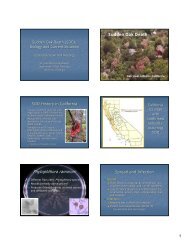Invasive Insects e Insects of Concern to Georgia
Invasive Insects e Insects of Concern to Georgia
Invasive Insects e Insects of Concern to Georgia
You also want an ePaper? Increase the reach of your titles
YUMPU automatically turns print PDFs into web optimized ePapers that Google loves.
Pho<strong>to</strong> from Penn. DCNR - Forestry Archives<br />
Emerald ash borer - Agrilus planipennis Fairmaire<br />
Emerald ash borer (EAB) is native <strong>to</strong> Asia. It is known <strong>to</strong> be<br />
established in Michigan, Ontario, Ohio, Indiana, Illinois, and Maryland.<br />
EAB probably arrived in the United States on solid wood packing<br />
material from Asia. U.S. pathways include the movement <strong>of</strong> infested<br />
ash trees, limbs, firewood, logs, and untreated ash lumber. Hosts<br />
include all ash species; however, green ash, white ash, and black ash are<br />
more susceptible than Asian varieties. Females lay eggs 2 weeks after<br />
emergence. During this time, adults feed on the leaves, making them<br />
irregularly notched. Eggs are initially light-yellow, turning <strong>to</strong> brownishyellow<br />
before hatching. Eggs hatch in 1-2 weeks, and the tiny larvae<br />
bore through the bark and in<strong>to</strong> the cambium layer. The creamy white<br />
larvae are 1 – 1 1/4 inches long with flat, broad, segmented bodies.<br />
Larvae feed in the cambium creating S-shaped, frass-packed tunnels.<br />
Adults begin emerging in mid-June leaving 0.1 – 0.2 inches “D”<br />
shaped emergence holes. It is a small, brassy-green, metallic woodboring<br />
beetle measuring 1/3 <strong>to</strong> 1/2 inches in length. Vertical splits in<br />
the bark are created by the tree forming callus tissue in response <strong>to</strong><br />
larval feeding. The damage by the larvae causes general yellowing and<br />
thinning <strong>of</strong> the foliage followed by crown dieback and the eventual<br />
death <strong>of</strong> the tree. Basal sprouting and the presence <strong>of</strong> woodpeckers<br />
may indicate wood-boring beetle activity. After 1 <strong>to</strong> 2 years <strong>of</strong><br />
infestation, the bark <strong>of</strong>ten falls <strong>of</strong>f in pieces from damaged trees,<br />
exposing the insect galleries. The life cycle in Michigan takes between<br />
1-2 years.<br />
Pho<strong>to</strong> from Penn. DCNR - Forestry Archives Pho<strong>to</strong> by D. Cappaert Pho<strong>to</strong> by D. Cappaert






